Live Log 2025: Ensembles Assembled
Live music in March was defined by three stellar performances featuring the Anzû Quartet, the JACK Quartet, and Wild Up
Three wide-ranging classical concerts by some of our most accomplished ensembles defined my live music in March. Here’s a brief look at what I saw and heard.
March 9th: Anzû Quartet, Roulette, Brooklyn
The debut album, Adjust, by this distinguished group of some of New York’s finest musicians, came out several weeks after this performance, and I’ve already trumpeted its excellence. Olivia de Prato (violin), Ken Thomson (clarinet), Ashley Bathgate (cello), and Karl Larson (piano) have each decorated my archives with many mentions for their performances, compositions, or recordings—or all three—so I was excited to see them coming together. Anzû was formed in homage to Olivier Messiaen’s Quartet for the End of Time, carrying forward the forces he drew on from the musicians in the prison of war camp in which he was imprisoned. It could be said that Anzû’s existence and its role as a commissioner of new works is yet a further triumph over the forces of darkness that put him there.
The first piece we heard at Roulette was Frictionless Objects (2023) by Ryan Carter, a composer and educator known for leveraging new technology, such as iPhone motion detection, while questioning its long-term effects. However, there was nothing high-tech about this dramatic and dynamic piece, which opened with a thundering piano and an effective dialogue between the strings and clarinet. About two-thirds of the way through, it gradually slowed down; the piano began to sparkle, and things started to fragment, growing ever eerier until it abruptly stopped. I was unfamiliar with Carter, but I now know that needs to change, and I’ll start with this 2022 portrait album.
Next was the world premiere of Mario Diaz de Leon’s Tree of Life, which presented a new mode for this composer of great power. Diaz de Leon often marshals dark sounds, as in 2023’s Spark and Earth, which combined electronics with heavy guitar. In this case, he gave us something lyrical, almost pastoral, with a delicate opening led by Larson and Bathgate. Soon, de Prato contributed swirling violin and Thomson unfurled long woody lines developing into a gorgeous flowering of melodic conversation. Even as things grew more staccato, there was a sense that Diaz de Leon offered consolation, a healing force for whatever ails you.
It’s no surprise that Tree of Life and the related electronic piece River of Life, which was recorded live at Roulette in 2023 but has only now been released, are both based on a beautiful passage from Revelations, 22:1-2: “Then the angel showed me the river of the water of life, as clear as crystal, flowing from the throne of God and of the Lamb down the middle of the great street of the city. On each side of the river stood the tree of life, bearing twelve crops of fruit, yielding its fruit every month. And the leaves of the tree are for the healing of the nations.” One need not be a believer to long for those leaves to grow in great quantities. Until then, we have Diaz de Leon’s wonderful music.
The final piece was Anna Webber’s Adjust (2022), which is on the album and received a smashing performance at Roulette. From the dense, angry opening and the hard rocking second movement, with unison riffage galore, to the slinky, barbed third movement, filled with wild pizzicato and witty finger tapping leading to a comical, bravura ending, that sounded like nothing so much as Raymond Scott’s cat chasing Carl Stalling’s mouse up the chimney, the band was on fire.
For the fourth movement, the lights dimmed to black, except for a spotlight on Larson, who played a series of searching chords that were eventually joined by trills from the clarinet and meditative lines from the strings. The busy, clockwork conclusion of the movement transitioned into a brief finale, which alternates between silence and tumult, growing increasingly unhinged until it fades into one extended note. Adjust is Webber’s first piece for chamber ensemble, and while the use of rhythm might belie her background in jazz, she has certainly “adjusted” well!
March 12th: JACK Quartet, Symphony Space, NYC
Inspired by Prospective Encounters, the contemporary music series created by Pierre Boulez in the early 70s, when he conducted the New York Philharmonic, Victoria Bond’s Cutting Edge Concerts has presented richly varied programs since 1998. I saw a wonderful Valerie Coleman concert in 2014, but it wasn’t until this year that the stars aligned for me to attend again
Bond scored a significant coup by having her season opened by the JACK Quartet, who brought a program that showcased both their instrumental prowess and a deeply informed approach to curation. Considering the roots of Bond’s series and the fact that we’re in Boulez’s centenary year, it was only natural that they opened with one of his pieces. Boulez composed only one work for string quartet, but his Livre Pour Quatuor (1948-49) offers its players considerable flexibility due to its conception as six separable movements. Of course, Boulez, being Boulez, was never satisfied with it, leaving the fourth movement unfinished and not completing the sixth until 1959.
Although Boulez withdrew the Livre from his catalog in the late 60s, the first two movements had a second life in his Livre pour cordes (1968), a much more assured work overall. But the original Livre was eventually revived and beautifully recorded by the Arditti Quartet. The JACK was more than up to the challenges of movements 1, 2, and 3c, gallivanting through them with great style. For most of its length, it sounded like nothing so much as a massive Calder mobile falling down multiple flights of stairs. As the JACK’s violinist, Austin Wulliman, noted, it was “Fragmented but sort of epic.”
Next was Anton Webern’s Six Bagatelles, op. 9 (1913), a series of finely detailed miniatures filled with so much information and emotion that you wish time would stop so you could fully absorb them. The JACK executed them beautifully, playing with clockwork precision and care.
Philip Glass’s String Quartet No. 5 (1991) was third on the program and, to be honest, I wasn’t looking forward to it. Aside from his scores for Koyaanisqatsi and Mishima, I’ve been mostly disenchanted with Glass’s music for decades. But I’m always humble enough to check my opinion at the door and open my ears to what’s in front of me. The JACK was mostly persuasive in the piece, and I was delighted by the songlike, optimistic flavor and the occasional romantic flourish. There were moments when Glass seemed to slip into that hobbyhorse sound of his, which briefly disrupted my enjoyment of the piece, but I would not rule out investigating his string quartets further.
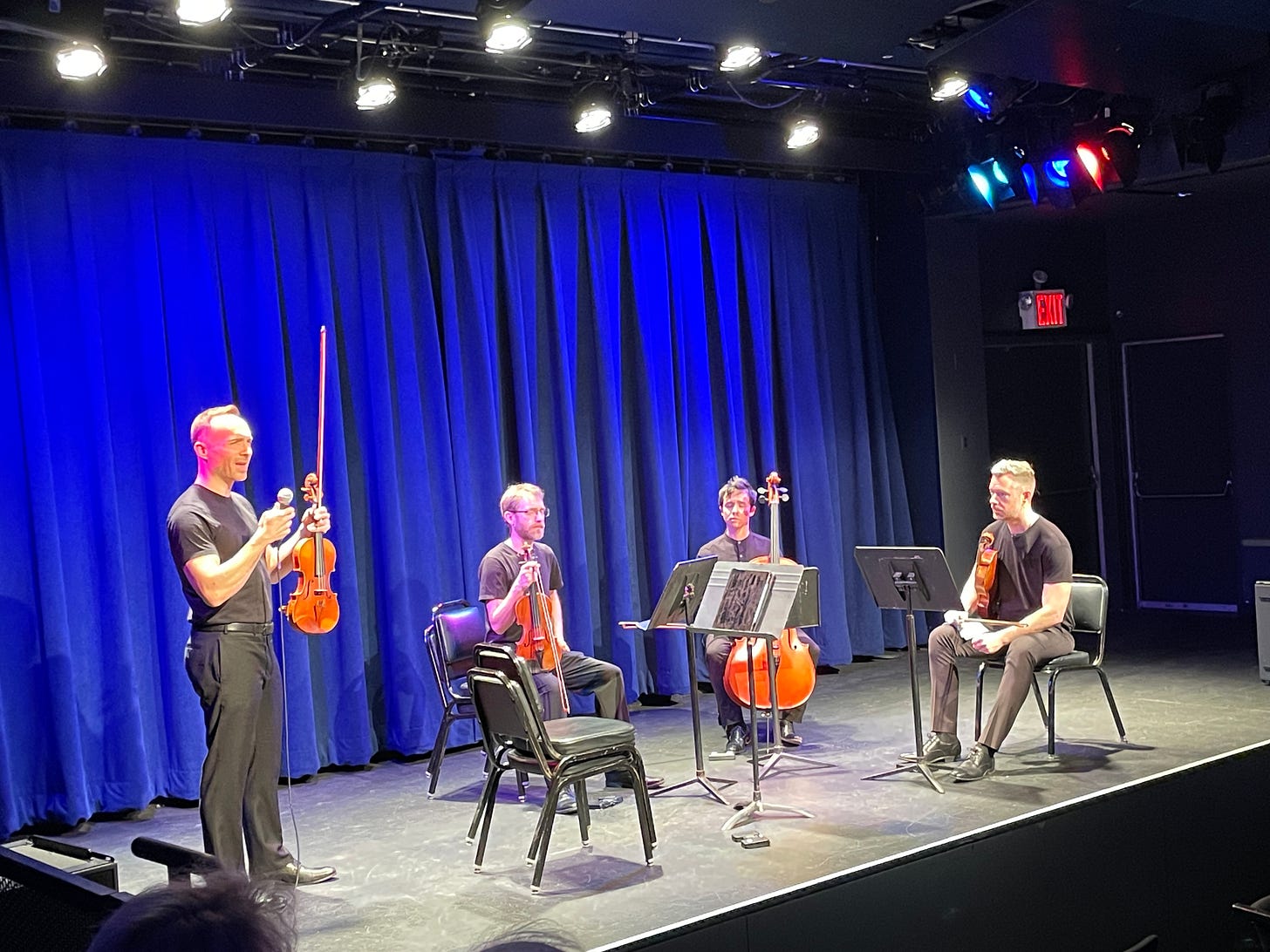
As at the Talea Ensemble’s concert in January, Boulez’s frenemy John Cage was here, too, with the JACK performing his String Quartet in Four Parts (1950). Basing it on the four seasons, Cage assigned each movement corresponding themes of creation (Spring), preservation (Summer), destruction (Fall), and quiescence (Winter). It’s a beautiful piece, too, almost Copland-esque in its pastoral quality and sense of narrative. The fourth movement is subtitled "Quodlibet," a glorious outburst that weaves the themes of the previous three movements together in a dance-like fashion. There’s a 2012 recording of the work by the JACK in their original lineup, but it does not hold a candle to the shapely, propulsive performance I heard.
The brilliant evening ended with Heinz Holliger’s String Quartet No. 2 (2007), which the now 85-year-old composer wrote over 30 years after his first work in the genre. As an oboist, Holliger has defined excellence for decades. Based on this airing by the JACK, I need to delve further into his compositions, especially the recent ones. Even at its spikiest, there was a sense of Holliger luxuriating in the sounds of the strings and possibilities for interaction, and the JACK returned the favor.
Based on the full room, the engaged audience, and the rapturous response, I’m not the only one who considers Victoria Bond’s Cutting Edge Concerts and the JACK Quartet essential parts of New York’s cultural life.
March 22nd: Wild Up, 92nd Street Y, NYC
I was thrilled when I heard Wild Up, the Los Angeles-based music collective, was bringing its Darkness Sounding series to the East Coast for the first time. Then, I nearly fell out of my chair when I saw that the Saturday concert featured the NYC premiere of Scott Walker’s final piece, Rubato (It: ‘Stolen Time’) (2017). Written for Wild Up in 2017, the piece has never been performed outside of Los Angeles or recorded, so I made it my business to be at the show.
Another attraction was the opportunity to hear Leilehua Lanzilotti’s with eyes the color of time (2021), which I loved on the wonderful recording the String Orchestra of Brooklyn released in 2022.
That the concert was taking place on the sixth anniversary of Walker’s death only made my anticipation greater as the lights began to dim after a brief introduction by conductor Christopher Rountree. He told us about the title, explaining that rubato is an expressive technique that allows a performer to “steal time” from one measure to use in another measure without losing the underlying rhythm. Walker’s use of it in the title is mysterious, however, as there are no markings for “rubato” in the score. Oddly enough, Rountree claimed not to understand Walker’s parenthetical, although it seems obvious that the “It” is short for “Italian.” Typically didactic, the well-read composer wanted us listeners to know that rubato is Italian for “stolen time.”
As is often the case with Walker, there are several meanings to explore around the idea of “stolen time.” For example, was Walker already diagnosed with the cancer that eventually killed him when he was working on the piece? That’s certainly something that would make someone feel like they were living on stolen or borrowed time. Was he thinking about his lost years in the early 70s, when alcoholism robbed him of years of productivity? Rountree also mentioned that the piece begins “with the sound of war.” Was Walker - a deep student of history - thinking about the lives cut short by global conflicts? We’ll likely never know the answer, but these were some of the thoughts in my head as the music began.
For Rubato, the string orchestra was supplemented by fixed media and trombones played by two giants: Mattie Barbier and Chris McIntyre. In Walker’s conception, the “sound of war” was conveyed by an electronic alarm soon joined by woozy strings and stentorian horns. As the tension built, grinding electronics interrupted the soundscape, competing with the brass—and winning. The sounds became increasingly confrontational before the piece suddenly shifted to a lovely choral section, with the ensemble showcasing their vocal skills. It was impossible to discern what words they were singing, but the hall was imbued with a feeling of peace. The singers stopped abruptly, revealing a recording that had been doubling them, which faded out in a haunting fashion.
Rubato (It: Stolen Time) is a stunning piece that draws on Walker’s soundtrack work but also points to what could have been a new direction for him. I hope it gets recorded someday, but as someone who has often wondered why the new music world hasn’t taken more note of Walker’s avant-garde song cycles, just hearing his music out loud in an assured performance was a very special experience. Much gratitude to Wild Up!
Before the ensemble began with eyes the color of time, Lanzilotti made a few remarks, noting that a central theme of the piece was the question, “When we deprioritize forward motion, what do we gain?”
What we gained were time-stopping, whispery violas that waxed and waned in strength and violins that hinted at a sweeping melody. After these repeated vignettes, the conventional strings dropped out, replaced by a breath-like sound produced by the double bass. Soon, other muted strings joined in, taking on the quality of a whispered, wordless hymn.
Introduced by a single descending violin line, a new melodic section began, sounding almost romantic in contrast. Then, accompanied by ticking and grinding violin noises, the low strings begin an ostinato-like pattern. But the wiry noise soon took over and grew in intensity before a sudden stop.
A mournful viola, underscored by distortions from the low strings, led to a brief burst of activity. A percussive section, featuring metallic sounds and raspy rattles created by rotating a disc filled with pellets, emerged. A viola interlude unveiled a new segment, which was passed around the strings like a message spreading through a crowd. It intensified, taking on a quality reminiscent of cells in a minimalist work, with rocking violas interlocking with trilling violins, supported by the low strings.
After quieting down to a whisper, a wordless chorus began that took us to the end. Listening to a recording of a magnificent piece like with eyes the color of time can make it feel like a quiet monolith. Watching Wild Up’s committed, engaged performance was like an X-ray that will enrich my experience of the piece in the future.
After the intermission, I was introduced to the music of Claude Vivier, a French-Canadian composer whose career was cut short when he was murdered in 1983 at the age of 34. A student of Karlheinz Stockhausen’s, Vivier developed a unique style based on many different traditions, from the Far East to his native Montreal.
The piece we heard, Zipangu (1980), was Vivier’s sole work for string orchestra, and he credited influences from Japanese kabuki and South Indian Carnatic music in its creation. Nothing about this powerful work sounded derivative, however, or even of its time. It entered in commanding fashion, all forward motion, as phalanxes of strings worked together, then at odds, then together again. Further drama arrived with rippling sound, as if the music needed to burst from within. Just a few minutes in, and the work already felt at war with itself.
Dark trajectories led to a furious violin solo, an agonized explosion, followed by an active sequence brought to a dramatic close by the thud of a bow on bass strings, like a leader calling: Halt. Ghostliness from the low strings was soon countered by high whistles from the violas and violins, until they cede ground again to the low notes. A droning consonance alternates with a busy violin section, until all join together. Violas sawing away, violins swooping and diving’s cellos and bass throbbing…then a unison phrase and FINI.
I doubt I was the only one looking forward to a deeper dive into Vivier’s work after this hard-charging performance - unless I was the only one late to the table!
The night ended with Saxony (1978) by James Tenney, another composer I need to look into. Composed for one or more saxophones and electronics, the piece is usually played in E-flat. Wild Up played it in an arrangement by Barbier for strings and trombones, transposed to the key of C. In their version, it began in a brooding, mysterious fashion, until the drone was interrupted by only a single pluck of pizzicato. Gradually, more light filtered in from the high strings, like sunrise on a wooded plain. Shadows began to fall, trombones adding to the bottom, and it soon became a warm pool that invited you to melt into it. A long, low drone ended the piece and the concert on a meditative note.
Rountree was a genial host and a laser-sharp, energetic conductor throughout. All the playing was stellar, with the kind of interaction usually seen among smaller ensembles. Based on the one night I saw, I hope Wild Up makes the eastward trek again and allows Darkness Sounding to resound in NYC next year.
From The Archives
A Braxton Spectacular At Miller
JACK In The Crypt
Farewell, Scott Walker
Best Of 2018: Classical
Best Of 14 (Part One)
Best Of 12 (Part One)

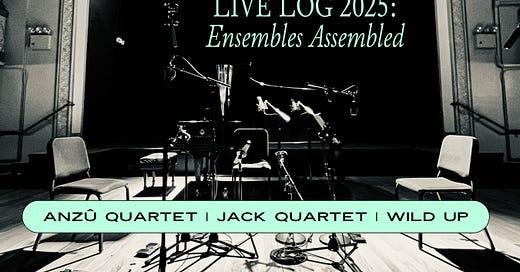



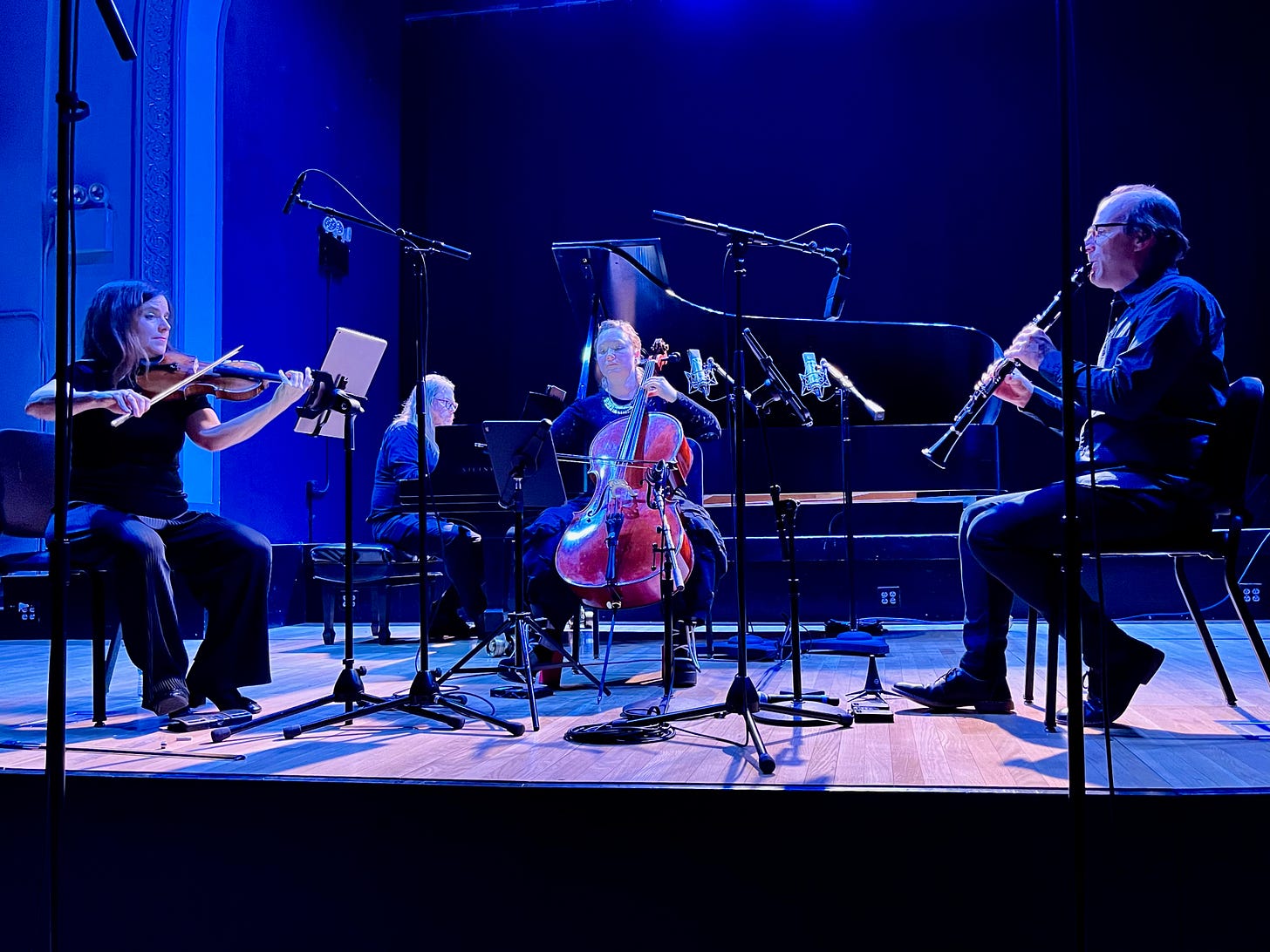

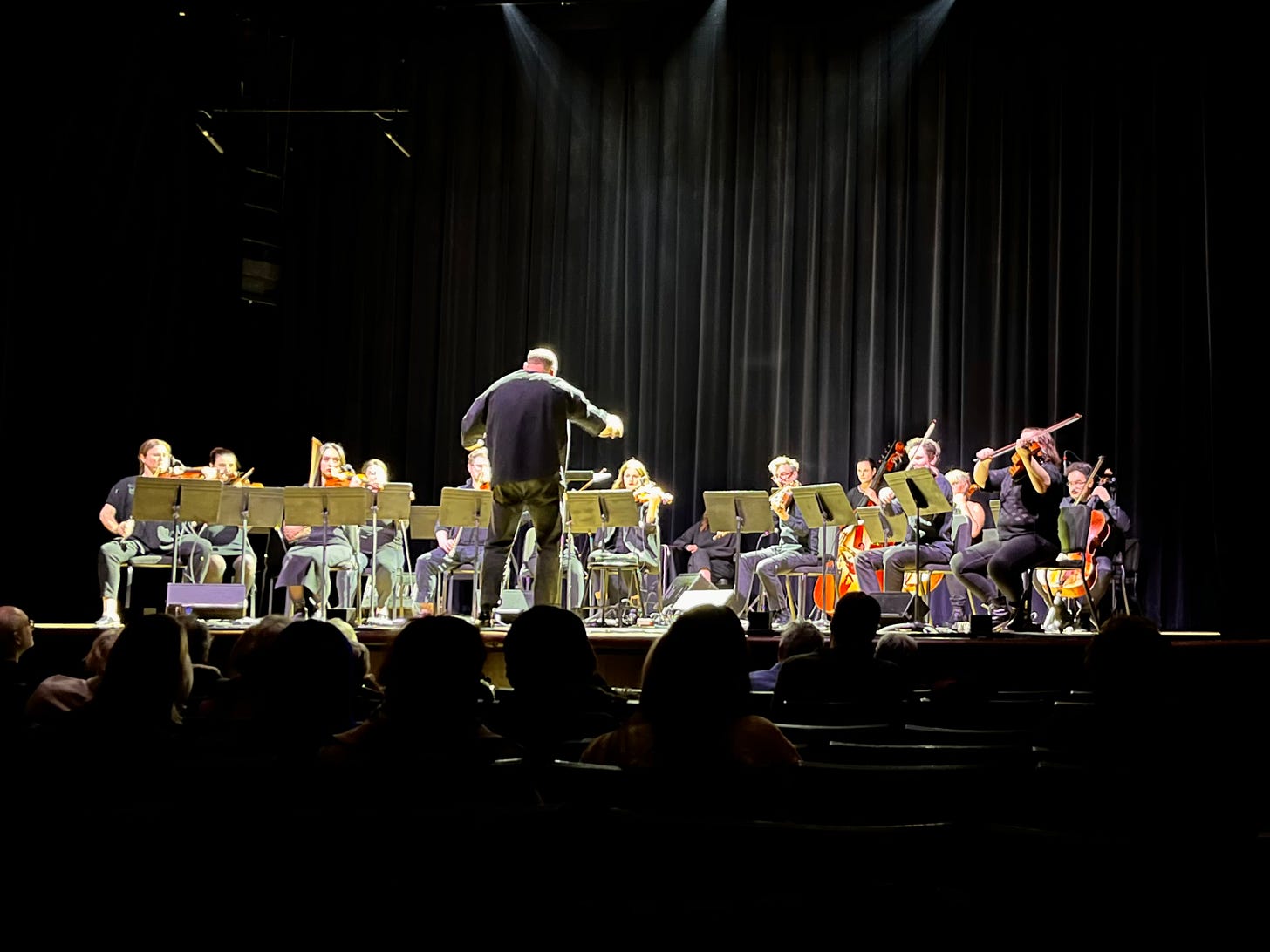
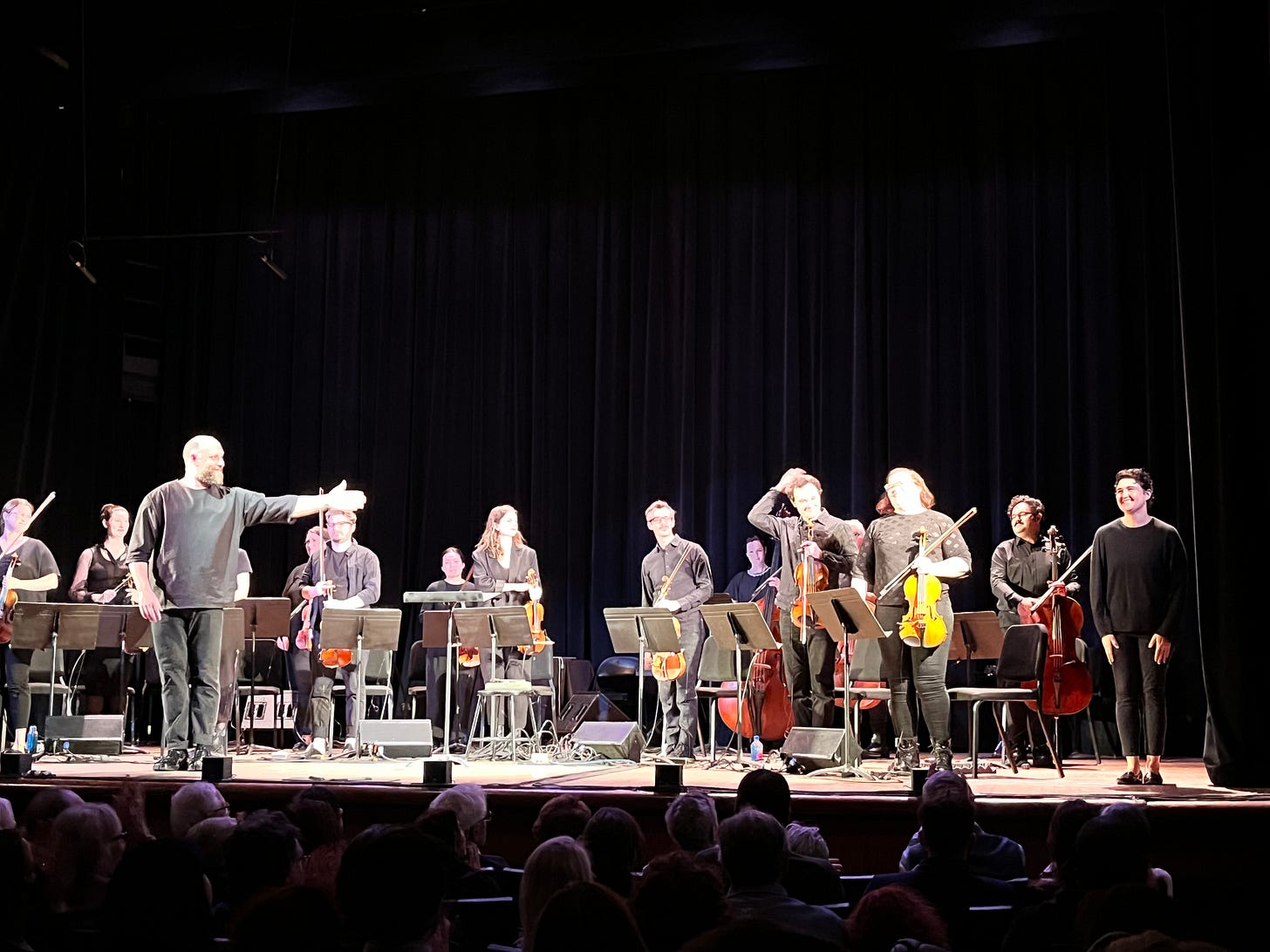
You've got great taste in live events ;^) Such a pleasure to re-experience all three of these shows through your writing.